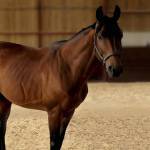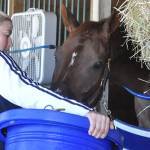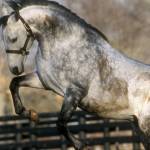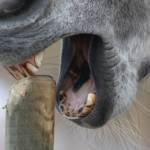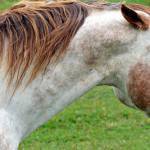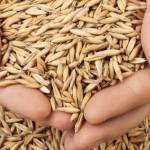Monitor Ulcer Healing in Horses by Testing Saliva Analytes
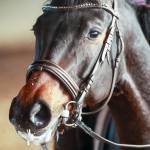
Experts say the only way to diagnose horses with equine gastric ulcer syndrome and assess response to treatment is by directly visualizing the lesions by gastroscopy. But what if there was another, simpler way? What if we could simply collect saliva on a sponge and analyze a few molecules to determine if the ulcers had healed, eliminating the need for repeat gastroscopies? This is exactly the approach one research group took, reporting that saliva does contain specific molecules that appear to indicate whether or not a horse’s gastric ulcers have healed.*
In that study, client-owned horses treated at the Large Animal Teaching Hospital at the University of Copenhagen were recruited. All horses were diagnosed with both glandular and squamous gastric ulcers and no other gastrointestinal abnormalities. All horses were treated with 4 mg/kg body weight omeprazole by mouth once daily one hour before feeding for six weeks. Saliva samples were collected using a sponge immediately before being sedated for gastroscopy at the time of diagnosing the gastric ulcers and again six weeks later at the time of follow-up.
Salivary analytes were selected based on previous studies and included enzymes (e.g., adenosine deaminase, lactate dehydrogenase, creatine kinase, aspartate aminotransferase), metabolites and proteins (e.g., total protein, triglycerides, ammonia, bicarbonate), and minerals (total calcium and phosphorus). All tests were performed using commercial test kits.
In total, 15 of the 28 horses (53.5%) responded to omeprazole, with a significant reduction in ulcer score for both glandular and squamous disease. In successfully treated horses, urea and bicarbonate levels in saliva were significantly higher after treatment. Further, a significant reduction in adenosine deaminase (ADA) and creatine kinase was noted following successful treatment.
“On the flip side, no changes in any salivary analytes were noted in the horses that did not respond to omeprazole therapy,” shared Kathleen Crandell, Ph.D., a nutritionist with Kentucky Equine Research.
These results suggested that ADA, creatine kinase, urea, and bicarbonate all have the potential to help identify horses that either did or did not respond to EGUS treatment.
“Using saliva as a source of biomarkers continues to be explored because of its noninvasive nature compared to gastroscopy. Collecting saliva is simple, stress-free, and painless, making it ideal for monitoring health,” shared Kathleen Crandell, Ph.D., a nutritionist for Kentucky Equine Research.
In addition to treating horses with omeprazole, owners were advised to implement other management strategies, such as minimizing stress, limiting the number of caretakers, and reducing the number of training days.
Nutrition also plays a role in managing gastric ulcers.
“Avoid large concentrate or high-starch meals, as well as long periods between feedings, as these all increase the risk of gastric ulcers,” advised Crandell.
In addition to suppressing acid production with omeprazole, consider buffering the acid with a research-proven digestive supplement. These buffers rapidly neutralize the acid secreted in the stomach, providing a more pH-neutral environment between meals,” Crandell said.
*Muñoz-Prieto, A., E. Llamas-Amor, J.J. Cerón, and S. Hensen. 2024. Changes in saliva analytes in equine gastric ulcer syndrome (EGUS) after treatment: a pilot study. Research in Veterinary Science: doi: 10.1016/j.rvsc.2024.105346.

